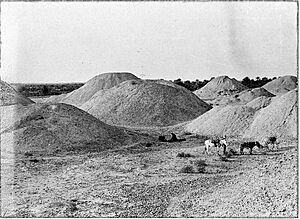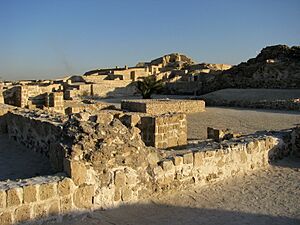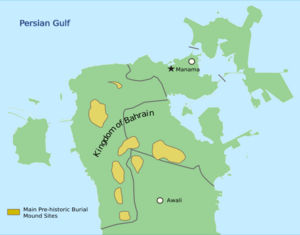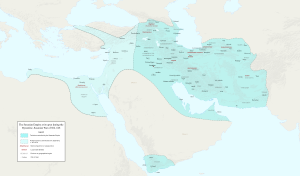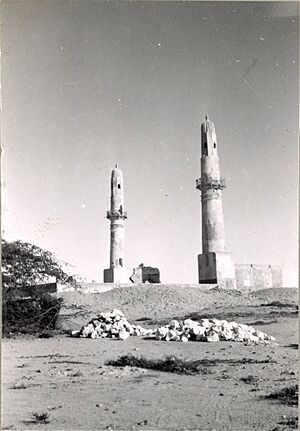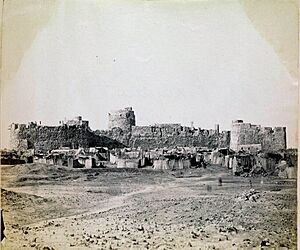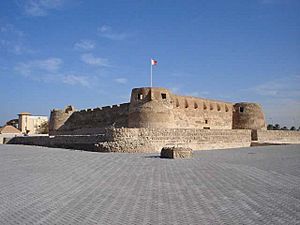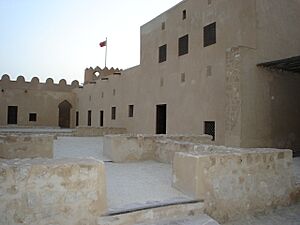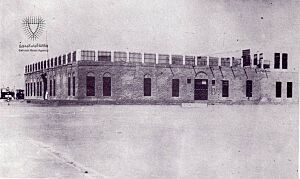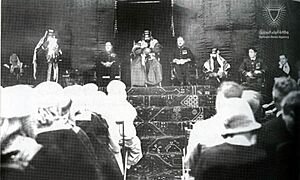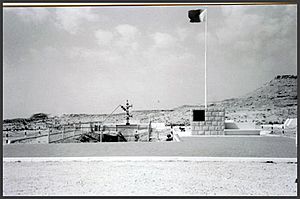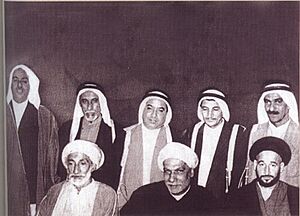History of Bahrain facts for kids
Bahrain has a long and interesting history! It was once a very important place for an ancient civilization called Dilmun. Because of its great location in the Persian Gulf, many different groups ruled or influenced Bahrain over time. These included the Persians, Sumerians, Assyrians, Babylonians, Portuguese, Arabs, and the British.
Contents
The Ancient Dilmun Civilization
Bahrain was a key part of the ancient Dilmun civilization. We first learn about Dilmun from old Sumerian writings on clay tablets. These tablets, found in the city of Uruk, are from around 4,000 BC! They mention Dilmun in connection with tools and supplies.
Later, letters from around 1370 BC mention Dilmun. These letters show that Dilmun had a connection with Babylon. After Babylon's power faded, Dilmun was mentioned by the Assyrians, who even claimed to be its king! The last time Dilmun was mentioned was around 567 BC, when it was controlled by the king of Babylon. After 538 BC, the name Dilmun was no longer used.
Dilmun was a major trading hub. There's proof of lots of trade between ancient Ancient Mesopotamia (modern-day Iraq) and the Indus Valley civilization (in modern-day Pakistan and India). Seals from the Indus Valley city of Harappa have been found in Mesopotamia, showing that goods were being sent back and forth.
Special round seals from Dilmun have been found in India and Mesopotamia. This proves that there was long-distance sea trade. What did they trade? Things like wood, ivory, lapis lazuli, gold, and fancy items like carnelian beads and pearls from the Persian Gulf. In return, they received silver, tin, wool, olive oil, and grains. They also traded copper from Oman and natural tar from Mesopotamia for cotton and chickens from the Indus region. The weights and measures used in Dilmun were even the same as those in the Indus Valley, not Mesopotamia!
Ancient writings tell us that "the ships of Dilmun, from the foreign land, brought him wood as a tribute." This shows how important Dilmun was for trade. Its "Golden Age" was from about 2200 BC to 1600 BC.
In ancient stories, Dilmun was sometimes called "the place where the sun rises" or "the Land of the Living." It's even mentioned in the famous Epic of Gilgamesh. Some myths say it's where the gods took the hero of the great flood, Utnapishtim, to live forever. It's also described as the place where creation happened in some stories.
Persian Empire Rule
From the 6th century BC to the 3rd century BC, Bahrain was an important part of the Persian Empire. This was a powerful Iranian family. After that, two other Iranian families, the Parthians and the Sassanids, controlled Bahrain until Islam arrived in the 7th century AD. The Parthians took control of the Persian Gulf around 130 BC to manage trade routes.
In the 3rd century AD, the Sassanids took over from the Parthians. Ardashir I, the first Sassanid ruler, conquered Oman and Bahrain. He made his son, Shapur I, the governor of Bahrain. Shapur even built a new city there! At this time, Bahrain included the southern coast of the Persian Gulf and the islands.
Tylos: The Greek Name for Bahrain
The ancient ancient Greeks called Bahrain "Tylos." It was known as a center for pearl trading. A Greek admiral named Nearchus, who worked for Alexander the Great, was one of the first Greeks to visit Tylos. He found a green land with a big trading network.
Nearchus wrote that Tylos had "large plantations of cotton tree." People made clothes from this cotton, some very expensive. The Greek historian Theophrastus also said that Tylos was famous for exporting walking sticks.
It's not clear if Bahrain was part of the Seleucid Empire, which was a Greek kingdom after Alexander. But Tylos was definitely influenced by Greek culture. The upper classes spoke Greek, and local coins even showed the Greek god Zeus. Tylos also held Greek sports competitions!
Some historians believe that the Phoenicians, famous ancient traders, originally came from Eastern Arabia, including Bahrain. The Greek historian Herodotus wrote that the Phoenicians came from the "Erythraean Sea" (the eastern part of the Arabian Peninsula) before moving to the Mediterranean. The name Tylos is thought to be a Greek version of the old name, Dilmun.
As Greek power faded, Tylos became part of a kingdom called Characene.
The Arrival of Islam
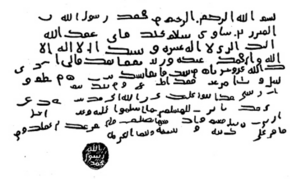
When Islam began in the 7th century, the name "Bahrain" referred to a much larger area along the Persian Gulf coast. Bahrain became Muslim in 629 AD. The Prophet Mohammed sent a representative to rule Bahrain. The Al Khamis Mosque, built in 692 AD, is one of the oldest mosques in Bahrain. Before Islam, Bahrain was a center for a Christian group called Nestorians.
Islam's growth didn't stop Bahrain's trade. In fact, when Baghdad became the center of Islamic civilization, Bahrain benefited greatly. It became a hub for thinkers and scholars for hundreds of years.
The Qarmatian Republic
Around 900 AD, a group called the Qarmatians started a rebellion. Their leader, Abu Sa'id al-Hasan al-Jannabi, took over Bahrain's capital and made al-Hasa his new capital. He wanted to create a perfect society based on fairness and reason.
The Qarmatians aimed for equality. All property was shared among members. They were organized in a special way, and new members had to go through seven stages of initiation.
The Qarmatians were very powerful in the Persian Gulf. They launched raids and even attacked Mecca in 930 AD, taking the sacred Black Stone. The stone was returned 22 years later. The Qarmatian state was very wealthy, with large farms worked by many people. They even had their own coins!
However, the Qarmatians were defeated in 976 AD. This led to their power fading, and another Arab family, the Uyunids, took over.
Uyunid and Other Dynasties
In 1076, Sheikh Abdullah bin Ali Al Uyuni took control from the Qarmatians and started the Uyunid dynasty. This family ruled Bahrain for 163 years. Their capital moved between Al-Hasa, Qatif, and Awal (which is Bahrain today). At one point, their territory stretched all the way to Kuwait and even the Syrian desert.
In 1253, conflicts within the Uyunid family allowed another group, the Usfurids, to take control of Eastern Arabia, including Bahrain. Later, in the mid-15th century, the Jabrids, another Bedouin family, took over Bahrain. They ruled most of Eastern Arabia.
Portuguese Rule
In the early 1500s, the Portuguese arrived in the Indian Ocean. They were looking for valuable trade routes. After taking control of the important Ormus region, they set their sights on Bahrain. Portuguese ships first entered the Gulf in 1485.
In 1521, a combined Portuguese and Hormuz force conquered Bahrain. They rebuilt the Qal'at al Bahrain fortress, which became their base. The Portuguese ruled Bahrain for about eighty years, even though there were several revolts against them.
In 1602, a popular uprising led by Rukn ed-Din drove the Portuguese out of Bahrain. This happened after the Portuguese governor ordered the execution of some rich traders. The Persian ruler, Shah Abbas I, quickly took control of Bahrain and made it part of the Safavid Empire.
Persian Safavid Rule and Omani Invasion
Under Persian Safavid rule (1602–1717), Bahrain was managed from far away. The Safavids tried to control the islands through ideas and by playing on local rivalries. This was a time when many important religious scholars lived in Bahrain.
However, the Safavid state became weak in the early 1700s. In 1717, Oman invaded Bahrain, ending over a hundred years of Persian rule. This started a time of great instability. Bahrain was sold back to the Persians by the Omanis, but then other local tribes took control.
In 1730, the new Shah of Persia, Nader Shah, tried to take Bahrain back. He succeeded in 1736. But Persian control weakened again later. The years of fighting and instability caused Bahrain's population to shrink. In 1763, a traveler found that Bahrain's 360 towns and villages had been reduced to only 60!
Invasion and British Protection
In 1782, a war started between the ruler of Bahrain and a group called the Bani Utbah clan from Zubarah (in modern Qatar). The Bani Utbah eventually invaded Bahrain Island in 1783. Historians disagree on the exact details, but it's believed that Ahmed Al Fateh led the invasion and defeated the ruler of Bahrain. Ahmed al-Fateh then ruled Bahrain and Zubarah.
The Persians tried to take Bahrain back in 1783 and 1785, but they failed. In 1799, Bahrain was threatened by the Sultan of Oman, Sayyid Sultan. The Bani Utbah asked for help from another group to expel the Omanis. Sayyid Sultan invaded again in 1800 and even appointed his young son as governor. But the Bani Utbah fought back and forced him out.
Treaties with Britain
In 1820, the Al Khalifa family, who were part of the Bani Utbah, regained power in Bahrain. They signed a treaty with Great Britain, which was becoming the most powerful country in the Persian Gulf. This treaty recognized the Al Khalifa as the rulers of Bahrain.
This treaty was similar to others Britain made with other Gulf states. It said that Bahrain's ruler couldn't give away any land or make deals with other foreign governments without Britain's permission. In return, Britain promised to protect Bahrain from attacks by sea and help if there was a land attack. This helped the Al Khalifa family stay in power.
In 1868, after a war between Qatar and Bahrain, Britain signed another agreement with the Al Khalifa rulers. This made Bahrain a British protectorate. This meant Britain would protect Bahrain, but also control its foreign relations. More agreements in 1880 and 1892 confirmed this status.
Economic Growth
Peace and trade brought new wealth to Bahrain. It became the most important trading center in the Persian Gulf by the mid-1800s, even more important than Basra, Kuwait, and Muscat. Bahrain started to become a modern state. Many merchant families from Persia, Huwala, and India moved to the island, making it a hub for trade routes across the Persian Gulf and to India.

These wealthy trading families became very powerful. Their wealth was huge, even before oil was discovered! Because of its trade with India, Bahrain's culture also became very influenced by India, seen in clothing, food, and education.
Early 20th Century Changes
When Britain fully took control in 1892, some people in Bahrain became unhappy. The first big uprising happened in 1895 against Sheikh Issa bin Ali, the ruler.
Between 1926 and 1957, Bahrain went through big social changes under the guidance of Charles Belgrave, a British advisor. The country's first modern school for boys opened in 1919, and the first girls' school in the Persian Gulf opened in 1928. Slavery was also ended. These changes were sometimes opposed by powerful groups, but the British helped push them through.
Discovery of Oil
In 1932, oil was discovered in Bahrain by the Bahrain Petroleum Company. This brought fast modernization to the country. Relations with the United Kingdom grew stronger, and the British Royal Navy even moved its Middle Eastern headquarters to Bahrain in 1935.
Bahrain helped the British Empire during World War II. In 1940, Italian bombers attacked Bahrain's oil refineries, but caused little damage. After the war, anti-British feelings grew in the Arab world, leading to riots in Bahrain.
The Leftist Movement
In 1954, a group called the National Union Committee (NUC) was formed. They wanted to end British involvement and bring about political changes. There were many strikes and sometimes riots. After riots in 1956, the British declared the NUC illegal and arrested its leaders.
Strikes and riots continued into the 1960s, led by underground groups. In March 1965, an uprising called the March Intifada broke out against the British presence. It started when many Bahraini oil workers were laid off.
Independent Bahrain
After World War II, Bahrain became the center for British administration in the lower Persian Gulf.
In 1968, the British Government announced it would end its treaties with the Gulf states. Bahrain tried to form a union with Qatar and the seven Trucial States (now the United Arab Emirates). But by mid-1971, they couldn't agree, so Bahrain decided to become independent on its own.
In 1969, Britain and Iran asked the United Nations to help decide Bahrain's future. In 1970, the UN asked the people of Bahrain if they wanted independence or Iranian control. The survey showed that most people wanted to be a fully independent country.
So, the United Nations Security Council passed a resolution on May 11, 1970, and Iran gave up its claim to the island. Bahrain officially became independent from the United Kingdom on August 15, 1971, and became the Kingdom of Bahrain on December 16, 1971.
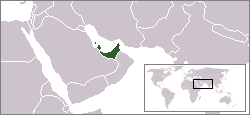
After independence, the British Royal Navy left Bahrain. The United States Navy then moved into the area, which later became Naval Support Activity Bahrain, the headquarters for the United States Fifth Fleet.
Bahrain's economy grew a lot after oil prices went up in 1973. Even though Bahrain's own oil was running out, its neighbors had huge oil wealth. Bahrain became a financial center, especially after the Lebanese Civil War in 1975, which made Beirut less stable. Bahrain offered a good location with many educated workers. This led to growth in other industries too.
This helped create a strong middle class in Bahrain. Many immigrants from countries like the Philippines, Pakistan, Egypt, and Iran came to Bahrain for better jobs.
The Constitutional Experiment
Based on its new 1973 constitution, Bahraini men elected its first National Assembly in 1973. The Assembly and the ruler, Emir Isa ibn Salman al-Khalifa, disagreed on several issues. The biggest disagreement was over the State Security Law, which allowed people to be arrested and held for a long time without trial.
Because of this disagreement, the emir dissolved the Assembly in 1975. He then passed the State Security Law by himself and stopped the parts of the constitution that gave the Assembly power. He also set up a special court whose decisions couldn't be appealed.
Iranian Revolution and Social Change
The rise of political Islam in the Middle East, especially the Iranian Revolution in 1979, had a big impact on Bahrain. Bahrain had always been more open than its neighbors because of its diverse population, including different Muslim groups and other faiths. This openness was also helped by the popularity of Arab nationalism.
But the Iranian Revolution changed things. In 1981, a group called the Islamic Front for the Liberation of Bahrain tried to overthrow Bahrain's leadership. This led to the formation of the Gulf Cooperation Council, which Bahrain joined with other Gulf states. The region felt more uncertain when Saddam Hussein's Iraq invaded Kuwait in 1990, leading to the 1991 Persian Gulf War.
The 1990s
The 1990s saw more calls for democratic changes in Bahrain. There were protests and about forty deaths. The unrest ended when Hamad bin Isa Al Khalifa became the Emir in 1999.
In December 1992, the emir appointed a Consultative Council. Protests followed the arrest of a religious leader, Sheikh Ali Salman, in 1994, who had called for the return of the National Assembly. He was later deported. There were also bomb explosions and more arrests. In June 1996, the government claimed to have stopped another coup plot.
The political problems continued, with violence between the government and its opponents. Over forty people were killed during this time.
In December 1998, Bahrain allowed the US and UK to use its military facilities for "Operation Desert Fox" against Iraq.
When Emir Sheikh Isa died in March 1999, his son, Hamad bin Isa Al Khalifa, took over. The new Emir pardoned Sheikh al-Jamri, a religious leader who had been jailed. For the first time, non-Muslims and women were appointed to the Consultative Council in 2000.
The 2000s
In 2001, Bahrainis strongly supported the emir's plans to make the country a constitutional monarchy with an elected parliament and independent courts. A vote in February 2001 showed massive support for this plan. The emir also gave women the right to vote and released all political prisoners.
As part of these changes, Bahrain officially changed its name from the State of Bahrain to the Kingdom of Bahrain in 2002.
Local elections were held in May 2002, where women could vote and run for office for the first time, though none won seats. Parliamentary elections were held in October 2002 for a 40-member parliament.
Bahrain helped in military action against the Taliban in Afghanistan in 2001. Because of this, the US called Bahrain a "major non-NATO ally" in November 2001. Bahrain did not support the invasion of Iraq. Relations with neighboring Qatar improved after a border dispute was settled in 2001. Bahrain also signed a free trade agreement with the United States in 2004.
Qatar and Bahrain have plans to build the Qatar-Bahrain Friendship Bridge, which would be one of the longest bridges in the world.
Bahraini Uprising (2011–Present)
Protests in Bahrain began on February 14, 2011. People initially wanted more political freedom and respect for human rights. A main reason for the protests was ongoing frustration among the Shiite majority with being ruled by the Sunni government. Protests in Tunisia and Egypt inspired these demonstrations.
The protests were mostly peaceful until police raided Pearl Roundabout in Manama on February 17, killing four protesters. After this, some protesters started calling for the end of the monarchy. On February 18, army forces shot at protesters trying to re-enter the roundabout, killing one. The next day, protesters reoccupied Pearl Roundabout after the government pulled back troops.
On March 14, forces from other Gulf countries, led by Saudi Arabia, entered Bahrain to help the government. The opposition called this an "occupation."
King Hamad bin Isa Al Khalifa declared a three-month state of emergency on March 15. On March 16, soldiers and police cleared the protest camp at Pearl Roundabout. Later, on March 18, the government tore down the Pearl Roundabout monument.
After the emergency law was lifted, opposition groups held more large rallies. Smaller protests and clashes continued almost daily. On March 9, 2012, over 100,000 people protested in what the opposition called "the biggest march in our history."
The police response was described as a "brutal" crackdown on "peaceful and unarmed" protesters. Many people were arrested, and some died in police custody. More than 120 people have died since the uprising began.
|
See also
 In Spanish: Historia de Baréin para niños
In Spanish: Historia de Baréin para niños
- Bahrain National Museum
- History of the Jews in Bahrain
- History of the Middle East
- Murair


